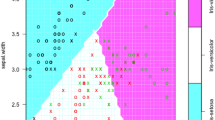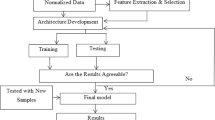Abstract
Purpose
The left ventricle (LV) myocardium undergoes deterioration with the reduction in ejection fraction (EF). The analysis of its texture pattern plays a major role in diagnosis of heart muscle disease severity. Hence, a classification framework with co-occurrence of local ternary pattern feature (COALTP) and whale optimization algorithm has been attempted to improve the prediction accuracy of disease severity level.
Methods
This analysis is carried out on 600 slices of 76 participants from Kaggle challenge that include subjects with normal and reduced EF. The myocardium of LV is segmented using optimized edge-based local Gaussian distribution energy (LGE)-based level set, and end-diastolic and end-systolic volumes were calculated. COALTP is extracted for two distance levels (d = 1 and 2). The t-test has been performed between the features of individual binary classes. The features are ranked using feature ranking methods. The experiments have been performed to analyze the performance of various percentages of features in each combination of bin for fivefold cross-validation. An integrated whale optimized feature selection and multi-classification framework is developed to classify the normal and pathological subjects using CMR images, and DeLong test has been performed to compare the ROCs.
Results
The optimized edge embedded to level set has produced better segmented myocardium that correlates with R = 0.98 with gold standard volume. The t-test shows that texture features extracted from severe subjects with distance level “1” are more statistically significant with a p value (< 0.00004) compared to other pathologies. This approach has produced an overall multi-class accuracy of 75% [confidence interval (CI) 63.74–84.23%] and effective subclass specificity of 70% (CI 55.90–81.22%).
Conclusion
The obtained results show that the multi-objective whale optimized multi-class support vector machine framework can effectively discriminate the healthy and patients with reduced ejection fraction and potentially support the treatment process.













Similar content being viewed by others
References
Mendis S, Puska P, Norrving B (2011) Global atlas on cardiovascular diseases prevention and control. World Health Organization in collaboration with the World Heart Federation and the World Stroke Organization—WHO Report
Lee DS, Gona P, Vasan RS, Larson MG, Benjamin EJ, Wang TJ, Tu JV, Levy D (2009) Relation of disease etiology and risk factors to heart failure with preserved or reduced ejection fraction: insights from the national heart, lung, and blood institute’s Framingham heart study. Circulation 119(24):3070–3077
Bax JJ, Poldermans D, Elhendy A, Cornel JH, Boersma E, Rambaldi R, Roelandt JR, Fioretti PM (1999) Improvement of left ventricular ejection fraction, heart failure symptoms and prognosis after revascularization in patients with chronic coronary artery disease and viable myocardium detected by dobutamine stress echocardiography. J Am Coll Cardiol 34(1):163–169
Rahimtoola SH (1997) Importance of diagnosing hibernating myocardium: how and in whom? J Am Coll Cardiol 30(7):1701–1706
Ayari R, Abdallah AB, Ghorbel F, Bedoui MH (2017) Analysis of regional deformation of the heart left ventricle. IRBM 38(2):90–97
Karamitsos TD, Dall’armellina E, Choudhury RP, Neubauer S (2011) Ischemic heart disease: comprehensive evaluation by cardiovascular magnetic resonance. Am Heart Journal 162(1):16–30
Saeed M, Liu H, Liang CH, Wilson MW (2017) Magnetic resonance imaging for characterizing myocardial diseases. Int J Cardiovasc Imaging 33(9):1395–1414
Hwang J, KimSM PSJ, Cho EJ, Kim EK, Chang SA, Lee SC, Choe YH, Park SW (2017) Assessment of reverse remodeling predicted by myocardial deformation on tissue tracking in patients with severe aortic stenosis: a cardiovascular magnetic resonance imaging study. J Cardiovasc Magn Reson 19:80
Peng P, Lekadir K, Gooya A, Shao L, Petersen SE, Frangi AF (2016) A review of heart chamber segmentation for structural and functional analysis using cardiac magnetic resonance imaging. Magn Reson Mater Phys Biol Med 29:155–195. https://doi.org/10.1007/s10334-015-0521-4
Ma Y, Wang L, Ma Y, Dong M, Du S, Sun X (2016) An SPCNN-GVF-based approach for the automatic segmentation of left ventricle in cardiac cine MR images. Int J Comput Assist Radiol Surg 11:1951–1964
Grosgeorge D, Petitjean C, Caudron J, Fares J, Dacher JN (2011) Automatic cardiac ventricle segmentation in MR images: a validation study. Int J Comput Assist Radiol Surg 6:573–581
Liu Y, Captur G, Moon JC, Guo S, Yang X, Zhang S, Li C (2016) Distance regularized two level sets for segmentation of left and right ventricles from cine-MRI. Magn Reson Imaging 34(5):699–706
Wu J, Mazur TR, Ruan S, Lian C, Daniel N, Lashmett H, Ochoa L, Zoberi I, Anastasio MA, Gach HM, Mutic S, Thomas M, Li H (2018) A deep Boltzmann machine-driven level set method for heart motion tracking using cine MRI images. Med Image Anal 47:68–80
Ngo TA, Lu Z, Carneiro G (2017) Combining deep learning and level set for the automated segmentation of the left ventricle of the heart from cardiac cine magnetic resonance. Med Image Anal 35:159–171
Feng C, Li C, Zhao D, Davatzikos C, Litt H (2013) Segmentation of the left ventricle using distance regularized two-layer level set approach. In: International conference on medical image computing and computer-assisted intervention, MICCAI 2013, pp 477–484
Ding K, Xiao L, Weng G (2017) Active contours driven by region-scalable fitting and optimized Laplacian of Gaussian energy for image segmentation. Sig Process 134:224–233
Zhang W, Fang B, Wu X, Qian J, Zheng S, Yang W, Zheng S (2017) An improved active contour model driven by region-scalable and local Gaussian-distribution fitting energy. In: International conference on security, pattern analysis, and cybernetics (SPAC), pp 417–422
Eftestol T, Maloy F, Engan K, Kotu LP, Woie L, Orn S (2014) A texture-based probability mapping for localisation of clinically important cardiac segments in the myocardium in cardiac magnetic resonance images from myocardial infarction patients. In: 2014 IEEE international conference on image processing, pp 2227–2231
Larroza A, López-Lereu MP, Monmeneu JV, Gavara J, Chorro FJ, Bodí V, Moratal D (2018) Texture analysis of cardiac cine magnetic resonance imaging to detect nonviable segments in patients with chronic myocardial infarction. Med Phys 45(4):1471–1480
Eftestol T, Woie L, Engan K, Kvaloy JT, Nilsen DWT (2012) Orn S (2012) Texture analysis to assess risk of serious arrhythmias after myocardial infarction. Comput Cardiol 39:365–368
Kotu LP, Engan K, Eftestol T, Woie L, Orn S, Katsaggelos AK (2012) Local binary patterns used on cardiac MRI to classify high and low risk patient groups. In: 2012 Proceedings of the 20th European signal processing conference, pp 2586–2590
Kotu LP, Engan K, Eftestol T, Orn S, Woie L (2011) Texture classification of scarred and non-scarred myocardium in Cardiac MRI using learned dictionaries. In: 18th IEEE International conference on image processing, pp 65–68
Engan K, Eftestol T, Orn S, Kvaloy TJ, Woie L (2010) Exploratory data analysis of image texture and statistical features on myocardium and infarction areas in cardiac magnetic resonance images. In: Annual international conference of the IEEE engineering in medicine and biology, pp 5728–5731
Baeßler B, Mannil M, Maintz D, Alkadhi H, Manka R (2018) Texture analysis and machine learning of non-contrast T1-weighted MR, images in patients with hypertrophic cardiomyopathy-preliminary results. Eur J Radiol 102:61–67
Baessler B, Mannil M, Oebel S, Maintz D, Alkadhi H, Manka R (2018) Subacute and chronic left ventricular myocardial scar: accuracy of texture analysis on nonenhanced Cine MR Images. Radiology 286(1):103–112
He R, Wang K, Li Q, Yuan Y, Zhao N, Liu Y, Zhang H (2017) A novel method for the detection of R-peaks in ECG based on K-nearest neighbors and particle swarm optimization. EURASIP J Adv Sig Process 2017:82. https://doi.org/10.1186/s13634-017-0519-3
Al-Tashi Q, Rais H, Jadid S (2018) Feature selection method based on grey wolf optimization for coronary artery disease classification. In: International conference of reliable information and communication technology, IRICT 2018: recent trends in data science and soft computing, pp 257–266
Usman AM, Yusof UK, Naim S (2018) Cuckoo inspired algorithms for feature selection in heart disease prediction. Int J Adv Intell Inform 4(2):95–106
Mirjalili S, Lewis A (2016) The whale optimization algorithm. Adv Eng Softw 95:51–67
Aziz MAE, Ewees AA, Hassanien AE (2018) Multi-objective whale optimization algorithm for content-based image retrieval. Multimed Tools Appl 77(19):26135–26172
Naghashi V (2018) Co-occurrence of adjacent sparse local ternary patterns: a feature descriptor for texture and face image retrieval. Optik 157:877–889
Oufaida H, Nouali O, Blache P (2014) Minimum redundancy and maximum relevance for single and multi-document Arabic text summarization. J King Saud Univ Comput Inf Sci 26(4):450–461
Gulgezen G, Cataltepe Z, Yu L (2009) Stable and accurate feature selection. In: Joint European conference on machine learning and knowledge discovery in databases, pp 455–468
Funding
This study has no funding.
Author information
Authors and Affiliations
Corresponding author
Ethics declarations
Conflict of interest
The authors declare that they have no conflict of interest.
Ethical approval
This article does not contain any studies with animals performed by any of the authors.
Informed consent
This study includes the images from publicly available database (https://www.kaggle.com/c/second-annual-data-science-bowl), and the database has been cited.
Additional information
Publisher's Note
Springer Nature remains neutral with regard to jurisdictional claims in published maps and institutional affiliations.
Rights and permissions
About this article
Cite this article
Muthulakshmi, M., Kavitha, G. An integrated multi-objective whale optimized support vector machine and local texture feature model for severity prediction in subjects with cardiovascular disorder. Int J CARS 15, 601–615 (2020). https://doi.org/10.1007/s11548-020-02133-y
Received:
Accepted:
Published:
Issue Date:
DOI: https://doi.org/10.1007/s11548-020-02133-y




